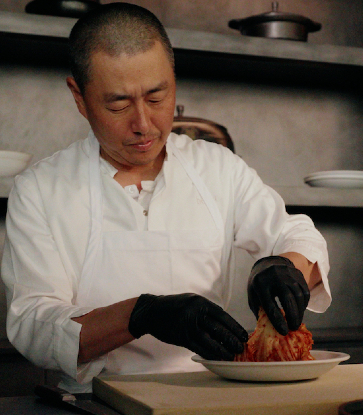One of them is the Chicken And Egg Rice, a comforting rice bowl of sweet glutinous rice with its umami factor amped up with chicken fat onion paste, chicken stock and butter. The rice is then topped with green peas, an onsen egg and crispy shards of chicken skin for texture.
Chef Matt Abergel, who hails from Canada, says: “The flavours of the chicken and egg rice closely mimic a dish that my grandmother would make, using rice, eggs, peas and chicken fat. It is sort of a Jewish fried rice.”

Besides chronicling how Yardbird was born, Chicken And Charcoal contains recipes from dishes at the seven-year-old restaurant, step-by-step instructions on butchering a chicken into parts such as the breast, thigh oyster, gizzard, liver and thyroid, seasoning them with marinades, placing the meat onto skewers and grilling the skewers over binchotan charcoal.
Abergel shares that Chicken And Egg Rice is inspired by his stint at three-Michelin-starred Japanese restaurant Masa in New York City that was run by chef Masayoshi Takayama, who is affectionately known as Masa. “The technique of cooking mochi rice in this way comes from Masa in one of his signature dishes — uni risotto,” Abergel shares. “I adapted it to be much more of a comfort food that is not nearly as refined.”
Abergel adds that Takayama “is and will always be the most influential person to the way that I not only cook and see food, but the ways in which all of these things intertwine”. In fact, he reveals in Chicken And Charcoal that Takayama’s love for yakitori sparked his interest in delving deeper into the craft of making chargrilled chicken skewers.
He recalls that Takayama was very generous with staff meals, especially on Saturday nights when the team would sit down for a fourth meal — a late-night meal after dinner — that involved more luxurious food, paired with beer or whisky. The Japanese chef, who also runs Bar Masa in New York City and Las Vegas, has a penchant for eating yakitori. The kitchen staff would order freshly slaughtered birds from poultry shop La Pera Brothers in Brooklyn, and they butchered and skewered them “the best way we knew how”.
He also honed his yakitori techniques from eating out with his partner, Lindsay, on Sundays. They spent many Sunday dinners at Yakitori Totto. He recalls: “We talked about how amazing it would be to have this kind of food and drink with a more informed, engaged, Western-style service. These ideas were the beginning of what would become Yardbird.” True enough, the couple uprooted to Hong Kong and opened Yardbird in 2011, which has grown into one of Hong Kong’s hottest restaurants.
Chicken And Charcoal ($55.50) is available at major bookshops now.

Serves 2
Ingredients
For the chicken-fat onion paste
200g chicken fat, rendered
4kg white onions, thinly sliced
20g sea salt
For the sweet glutinous mochi rice
300g sweet glutinous mochi rice
200ml cooking sake
2g sea salt
240ml chicken stock
20g unsalted butter
3g salt
30g sweet peas (or petit pois), shelled
10g spring onions, chopped
1 onsen egg
Crispy chicken skin, 80g or six pieces
Method
1. To make the chicken-fat onion paste, in a large pot over medium-low heat, melt the rendered chicken fat. Add onions and salt to melted fat and slowly caramelise the onions, while stirring the mixture for two hours until they turn deep brown.
2. Allow the onions to cool in the fat, puree the mixture in a food processor to make a smooth paste. Set aside in refrigerator until it is ready to be used.
3. To prepare the rice, rinse the rice thoroughly until the water becomes clear. Soak the rice in water overnight.
4. The next day, drain the rice and air-dry it till the grains are bright white and dry to touch (this process takes 30 minutes to one hour).
5. Dissolve sea salt into sake and mix the salted sake into the rice.
6. Line a bamboo steamer with muslin cloth and spread the rice evenly in the steamer. The layer of rice should be no more than 2.5cm deep.
7. Steam the rice over high heat for six to nine minutes until it is cooked through but not overly soft. Set rice aside to cool.
8. Heat a medium-sized saute pan over medium-low heat. Add 80g of the chicken fat paste prepared to the pan. Cook the paste for two minutes till it has slightly melted.
9. In the same pan, add the par-cooked sticky rice that was prepared earlier.
10. With a wooden spoon, stir the mixture until the rice is mixed through. The rice should absorb some of the onions and fats at this point.
11. Switch to medium-high heat, add chicken stock into the pan, about 50ml at a time, and stir the mixture constantly so that the rice does not stick to the bottom of the pan. Continue stirring until the rice has absorbed all the stock and has the consistency of a loose risotto, which still has slight bite to the rice.
12. Turn off the heat, add butter, salt and sweet peas into the pan.
13. To serve, heat a small cast-iron skillet or frying pan. Starting at the centre, ladle the rice into the skillet and let the rice mound naturally in the middle of the skillet or pan. Make a small well in the centre of the rice for the onsen egg.
14. Scatter chopped spring onions over the rice, crack the onsen egg into the centre of the well in the rice.
15. Garnish with crispy chicken skin on top of the rice. Serve immediately. Mix everything together before eating.






















